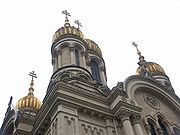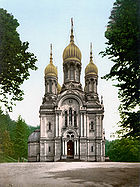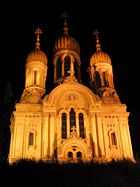
St. Elizabeth's Church, Wiesbaden
Encyclopedia





Russian Orthodox Church
The Russian Orthodox Church or, alternatively, the Moscow Patriarchate The ROC is often said to be the largest of the Eastern Orthodox churches in the world; including all the autocephalous churches under its umbrella, its adherents number over 150 million worldwide—about half of the 300 million...
church in Wiesbaden
Wiesbaden
Wiesbaden is a city in southwest Germany and the capital of the federal state of Hesse. It has about 275,400 inhabitants, plus approximately 10,000 United States citizens...
, Germany and is located on Neroberg
Neroberg
Neroberg is a mountain of Hesse, Germany....
. Besides the Russian church there is a parsonage and a Russian cemetery, which is the largest in Europe (outside Russia itself). St. Elizabeth's Church and its parishioners belong to the Diocese of Germany in the Russian Orthodox Church Outside Russia
Russian Orthodox Church Outside Russia
The Russian Orthodox Church Outside Russia , also called the Russian Orthodox Church Abroad, ROCA, or ROCOR) is a semi-autonomous part of the Russian Orthodox Church....
.
History
The Russian Orthodox Church in Wiesbaden was built from 1847 to 1855 by Duke AdolfAdolphe, Grand Duke of Luxembourg
Adolphe I, Grand Duke of Luxembourg was the last Duke of Nassau, and the fourth Grand Duke of Luxembourg.-Biography:...
of Nassau
House of Nassau
The House of Nassau is a diversified aristocratic dynasty in Europe. It is named after the lordship associated with Nassau Castle, located in present-day Nassau, Rhineland-Palatinate, Germany. The lords of Nassau were originally titled Count of Nassau, then elevated to the princely class as...
on the occasion of the early death of his wife, the 19-year-old Russian princess Elizabeth Mikhailovna
Grand Duchess Elizabeth Mikhailovna of Russia
Grand Duchess Elizabeth Mikhailovna of Russia was the second child and daughter of Grand Duke Mikhail Pavlovich of Russia and Princess Charlotte of Württemberg who took the name Elena Pavlovna upon her conversion to the Orthodox faith...
, Grand Duchess of Russia and Duchess of Nassau (1826-1845). This was the daughter of Michael Romanov
Grand Duke Michael Pavlovich of Russia
Grand Duke Michael Pavlovich of Russia was the tenth child and fourth son of Paul I of Russia and Sophie Dorothea of Württemberg.-Marriage and issue:In St...
(1798-1849), the younger brother of Tsar Alexander I
Alexander I of Russia
Alexander I of Russia , served as Emperor of Russia from 23 March 1801 to 1 December 1825 and the first Russian King of Poland from 1815 to 1825. He was also the first Russian Grand Duke of Finland and Lithuania....
(reigned 1801-1825) and Nicholas I
Nicholas I of Russia
Nicholas I , was the Emperor of Russia from 1825 until 1855, known as one of the most reactionary of the Russian monarchs. On the eve of his death, the Russian Empire reached its historical zenith spanning over 20 million square kilometers...
(reigned 1826-1855). Adolf and the princess married in 1844, but the following year, she died in childbirth, as did their newborn daughter. He grieved so profoundly that he decided to build a church around her grave. He obtained the money for this church, with the blessing of Tsar Nicholas, from her dowry.
Construction of the church was assigned to senior building officer (Oberbaurat) Philipp Hoffmann, who studied Russian church architecture, particularly at first in Russia. As a template for this church, he took the Cathedral of Christ the Saviour
Cathedral of Christ the Saviour (Moscow)
The Cathedral of Christ the Saviour is a Church in Moscow, Russia, on the northern bank of the Moskva River, a few blocks south-west of the Kremlin...
in Moscow. On 25 May 1855 the church was finally dedicated in honour of St. Elizabeth
Elizabeth (Biblical person)
Elizabeth is also spelled Elisabeth or Elisheva...
, the mother of John the Baptist
John the Baptist
John the Baptist was an itinerant preacher and a major religious figure mentioned in the Canonical gospels. He is described in the Gospel of Luke as a relative of Jesus, who led a movement of baptism at the Jordan River...
and patron saint of the deceased princess. Shortly afterwards, the coffin containing the late princess and her baby was taken in a procession from the Bonifatiuskirche, its previous temporary shelter, into the crypt of the Russian church and buried there.
Simultaneously with the construction of the church were built a small rectory and a Russian cemetery, located about 100 meters northeast of the church.
The church was used by the already-existing Russian Orthodox community, mainly Russian guests, for whom Wiesbaden was a popular resort in the 19th century. Even Tsar Nicholas II
Nicholas II of Russia
Nicholas II was the last Emperor of Russia, Grand Prince of Finland, and titular King of Poland. His official short title was Nicholas II, Emperor and Autocrat of All the Russias and he is known as Saint Nicholas the Passion-Bearer by the Russian Orthodox Church.Nicholas II ruled from 1894 until...
worshipped in the church during his stay in Germany, together with his newly wedded-wife, the Tsarina Alexandra Fyodorovna. This event is noted on a gold panel attached to the church.
A lasting community formed around the church only in the 1920s, when many White Emigre
White Emigre
A white émigré was a Russian who emigrated from Russia in the wake of the Russian Revolution and Russian Civil War, and who was in opposition to the contemporary Russian political climate....
s fled in the wake of the Russian Revolution, the Russian Civil War
Russian Civil War
The Russian Civil War was a multi-party war that occurred within the former Russian Empire after the Russian provisional government collapsed to the Soviets, under the domination of the Bolshevik party. Soviet forces first assumed power in Petrograd The Russian Civil War (1917–1923) was a...
and the Bolshevik
Bolshevik
The Bolsheviks, originally also Bolshevists , derived from bol'shinstvo, "majority") were a faction of the Marxist Russian Social Democratic Labour Party which split apart from the Menshevik faction at the Second Party Congress in 1903....
takeover of their country and came to Germany.
During the 1990s, the interior of the church, particularly its marble and frescoes, was renovated and restored. The crypt was renovated in 2002–2005.
Exterior
The church is a beige building of hard sandstone, still visible everywhere on the outside. The outer layout of the church is a square with an extended arc in the north. The building is "crowned" with five fiery-gilt domes, with the four smaller ones surrounding the large central dome to the northeast, northwest, southeast and southwest. The domes, typically for Russian churches, are onion-shaped and have grooves running lengthwise from top to bottom. Each dome is topped by a similarly gilt Orthodox crossPatriarchal cross
The Patriarchal cross is a variant of the Christian cross, the religious symbol of Christianity. Similar to the familiar Latin cross, the Patriarchal cross possesses a smaller crossbar placed above the main one, so that both crossbars are near the top. Sometimes the patriarchal cross has a short,...
. All crosses point to the south; the cross in the center is above and slightly larger than the other four, which are of the same size.
The domes rest on smaller cylindrical towers, with the main one in the centre higher and wider than the others. This is also at the top under the dome completely covered with window panes cover, so that here, light can fall directly into the interior of the church. The smaller towers have rather narrow, oblong windows, through which the light falls only inside the tower, since these are not connected with the interior. The northeast tower is an exception: this contains a spiral staircase, the entrance of which is directly under the dome; from here it is possible to reach the roof of the church by a small gate in the tower.
The church has two entrances: the south and the west entrance. The south entrance was originally only for Fürst
Fürst
Fürst is a German title of nobility, usually translated into English as Prince.The term refers to the head of a principality and is distinguished from the son of a monarch, who is referred to as Prinz...
en and other members of the nobility. It offered visitors leaving the building a panorama of Wiesbaden, which stood at the feet of the church. After the fall of the last Tsar, Nicholas II, in 1917, this entrance was sealed forever. The entrance for the "ordinary people" and the current main entrance was the west entrance. Visitors entering the church through this door see, as in most Russian Orthodox churches, the iconostasis
Iconostasis
In Eastern Christianity an iconostasis is a wall of icons and religious paintings, separating the nave from the sanctuary in a church. Iconostasis also refers to a portable icon stand that can be placed anywhere within a church...
opposite. Medallions of particular saints, crafted from sandstone, are located above the outside entrances. A medallion of Saint Helena
Helena of Constantinople
Saint Helena also known as Saint Helen, Helena Augusta or Helena of Constantinople was the consort of Emperor Constantius, and the mother of Emperor Constantine I...
rests above the west entrance; at the southern entrance, one of Saint Elizabeth (in whose honour the church was also consecrated); and on the east side, above the window of the sanctuary, one of the Holy Archangel Michael
Michael (archangel)
Michael , Micha'el or Mîkhā'ēl; , Mikhaḗl; or Míchaël; , Mīkhā'īl) is an archangel in Jewish, Christian, and Islamic teachings. Roman Catholics, Anglicans, and Lutherans refer to him as Saint Michael the Archangel and also simply as Saint Michael...
. These were the patron saints of the father (Mikhail) and mother (Elena) of the Grand Duchess, as well as her own (Elizabeth). Approximately ten steps of red sandstone lead up to the entrance, which is spanned by an arch that in turn sits on each side upon two columns.
Other information
The church building was featured twice on stamps of the Deutsche BundespostDeutsche Bundespost
The Deutsche Bundespost was created in 1947 as a successor to the Reichspost . Between 1947 and 1950 the enterprise was called Deutsche Post...
in the Sights definitive
Definitive stamp
A definitive stamp is a postage stamp, that is part of a regular issue of a country's stamps available for sale by the postal service for an extended period of time...
series (4 June 1991, face value 170 pfennig
Pfennig
The Pfennig , plural Pfennige, is an old German coin or note, which existed from the 9th century until the introduction of the euro in 2002....
, intended to pay the double weight domestic letter rate; and 12 August 1993, with a revised face value of 41 pfennig for mass mailings of printed matters).
In addition, there is an illustration of the church on tourist signs on the Autobahnen around Wiesbaden.

